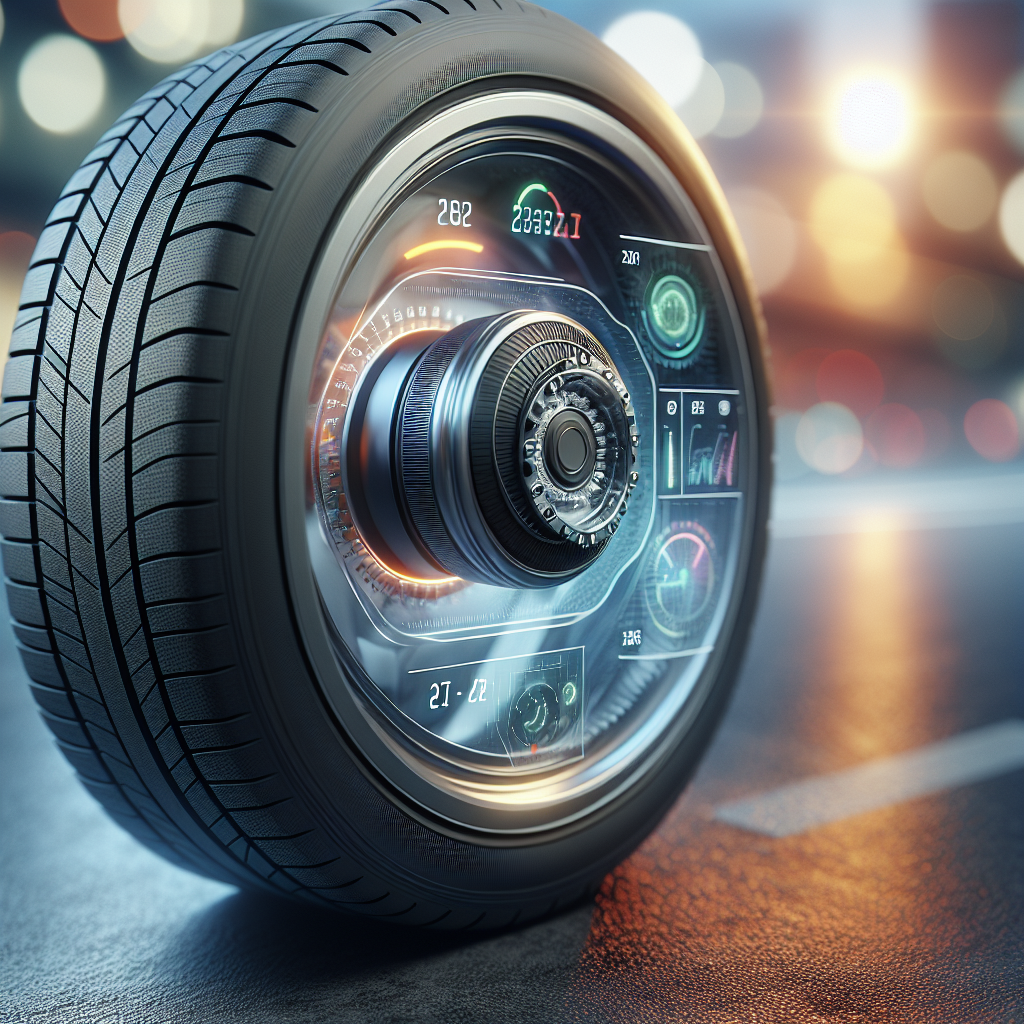In today’s fast-paced world, ensuring the safety and efficiency of your vehicle is paramount. A Tyre Pressure Monitoring System (TPMS) serves as an essential tool in this regard, providing real-time data on tire pressure. This technology not only enhances safety but also improves fuel efficiency and extends tire life.
At its core, a TPMS consists of sensors that monitor the air pressure in each tire. These sensors communicate vital data to the vehicle’s onboard computer system, alerting drivers to any significant drops in pressure. The importance of maintaining proper tire pressure cannot be overstated; under-inflated tires can lead to dangerous driving conditions, increased fuel consumption, and accelerated tire wear.
The operation of a TPMS relies on two main types of systems: direct and indirect. Direct TPMS uses sensors located inside the tire to measure the actual pressure, offering precise readings. In contrast, indirect TPMS estimates tire pressure using wheel speed sensors and can be less accurate. Regardless of the type, the goal is the same: to keep drivers informed and safe.
By integrating a TPMS into your trailer, you can significantly enhance your awareness of tire conditions. Tow with peace of mind, knowing that trailerwatchdog is standing guard.
Understanding the Components of TPMS

To fully grasp how tyre pressure monitoring system works, it is essential to understand its core components. A TPMS is comprised of several key elements that work together to ensure accurate monitoring of tire pressure.
- Sensors: These are the heart of the system, typically located inside each tire. They measure the tire's air pressure and temperature, sending this data to the vehicle's onboard computer.
- Receiver: The receiver collects information from the sensors. In a direct TPMS, it relays real-time pressure readings, while in an indirect system, it interprets speed data to estimate pressure levels.
- Display Unit: This is the interface for the driver, often integrated into the vehicle’s dashboard. It visually alerts the driver when tire pressure falls below the recommended level, enabling timely action.
- Battery: Most TPMS sensors are equipped with a battery that powers the sensor and transmits data. Understanding the lifespan of this battery is crucial, as a depleted battery can lead to malfunctioning sensors.
- Control Module: This component processes the data received from the sensors and communicates with the display unit. It is responsible for interpreting the information and making decisions about alerts.
By comprehending these components, drivers can appreciate the sophistication of their TPMS and its role in enhancing vehicle safety. Each part plays a crucial role in delivering reliable tire pressure information, ultimately helping to prevent accidents and extend tire life.
How Tyre Pressure Monitoring Systems Function

Understanding how tyre pressure monitoring system works is crucial for ensuring vehicle safety and performance. The operation of a TPMS can be categorized into two main types: direct and indirect systems, each functioning in distinct ways.
Direct TPMS: In a direct system, each tire is equipped with a dedicated sensor that continuously monitors both tire pressure and temperature. When the vehicle is in motion, these sensors transmit real-time data to the central control unit. If the pressure drops below a preset threshold, the system triggers a warning light on the dashboard, alerting the driver. This immediate feedback allows for quick action, potentially preventing blowouts and improving fuel efficiency.
Indirect TPMS: Conversely, an indirect TPMS does not rely on dedicated sensors in each tire but instead utilizes the vehicle's antilock braking system (ABS) to gauge tire pressure. It does this by monitoring the rotational speed of each tire. If a tire is under-inflated, it will rotate faster than properly inflated tires, prompting the system to deliver a warning. While indirect systems can be less expensive and easier to maintain, they may not provide as precise readings as direct systems.
Regardless of the type, both systems play a vital role in enhancing safety by alerting drivers to potential tire issues. By maintaining optimal tire pressure, drivers can improve handling, fuel efficiency, and overall vehicle longevity.
Benefits of Using a TPMS in Vehicles
Incorporating a Tyre Pressure Monitoring System (TPMS) into vehicles offers a myriad of benefits that significantly enhance safety and efficiency on the road. Here are some of the most notable advantages:
- Improved Safety: One of the primary benefits of a TPMS is the enhanced safety it provides. By constantly monitoring tire pressure, it helps prevent blowouts and loss of vehicle control caused by under-inflated tires.
- Fuel Efficiency: Maintaining proper tire pressure directly impacts fuel efficiency. Under-inflated tires increase rolling resistance, causing the engine to work harder and consume more fuel. A TPMS helps ensure tires are always inflated to the optimal pressure, leading to better mileage.
- Extended Tire Life: Properly inflated tires wear more evenly, resulting in longer tire life. By using a TPMS, drivers can avoid premature tire replacements and save on costs associated with maintaining tires.
- Real-Time Monitoring: With direct TPMS, drivers receive real-time data about tire conditions, allowing for immediate action if any issues arise. This proactive approach can prevent small problems from escalating into major safety concerns.
- Environmental Benefits: By improving fuel efficiency and extending tire life, TPMS contributes to reduced greenhouse gas emissions. This makes it not only a smart choice for the vehicle owner but also an environmentally friendly one.
In summary, the benefits of using a TPMS are extensive, making it an essential component for modern vehicles. By ensuring optimal tire performance, drivers can enjoy a safer and more efficient driving experience.
Common Issues with Tyre Pressure Monitoring Systems

While a Tyre Pressure Monitoring System (TPMS) is a valuable tool for enhancing vehicle safety and performance, there are common issues that users may encounter. Understanding these challenges can help drivers maintain their TPMS effectively. Here are some prevalent problems:
- Sensor Malfunction: One of the most common issues is sensor failure. Sensors may become damaged due to road debris or extreme weather conditions, leading to inaccurate readings or complete system failure.
- Battery Life: TPMS sensors are often powered by batteries that have a limited lifespan. When the battery depletes, the sensor will stop functioning, resulting in warnings on the dashboard and potentially unsafe driving conditions.
- Improper Calibration: After tire changes or rotations, TPMS sensors may require recalibration. Failure to do this can lead to incorrect pressure readings, causing further issues with tire performance and safety.
- Interference from Other Devices: In some cases, TPMS signals can be disrupted by other electronic devices in the vehicle, leading to false alerts. This interference may require troubleshooting to ensure proper function.
- Environmental Factors: Rapid changes in temperature can affect tire pressure, leading to false alarms. Additionally, road conditions such as potholes or rough terrain may impact sensor accuracy.
Awareness of these common issues enables vehicle owners to take proactive steps in maintaining their TPMS. Regular checks and timely responses to alerts can prevent minor issues from escalating into serious safety concerns.
Maintaining Your Tyre Pressure Monitoring System

Proper maintenance of your Tyre Pressure Monitoring System (TPMS) is essential to ensure its longevity and effectiveness. By regularly monitoring and caring for your system, you can enhance your vehicle's safety and performance on the road. Here are some vital tips for maintaining your TPMS:
- Regularly Check Tire Pressure: It’s crucial to frequently check the tire pressure manually, even if your TPMS is functioning well. This ensures that you catch any discrepancies early before they lead to more significant issues.
- Inspect Sensors: Periodically inspect the sensors for any signs of damage or corrosion. Ensuring they are clean and free from debris can help maintain accurate readings.
- Replace Batteries as Needed: Keep track of your TPMS sensor battery life and replace them as necessary. Most sensors will alert you when the battery is low, but it’s wise to replace them preemptively during tire service.
- Stay Informed on Calibration: After tire rotations or replacements, always ensure that your TPMS is properly calibrated. This can usually be done during routine tire maintenance.
- Use Quality Tires: Pairing your TPMS with high-quality tires can reduce the wear and tear on the sensors and improve overall tire performance.
Maintaining your TPMS is not just about keeping the system operational; it’s about ensuring your safety and efficiency while driving. For peace of mind on your journeys, consider integrating advanced trailer monitoring solutions. Tow with peace of mind, knowing that trailerwatchdog is standing guard.








